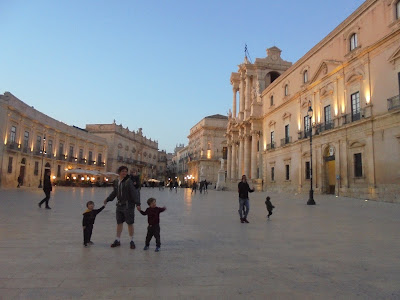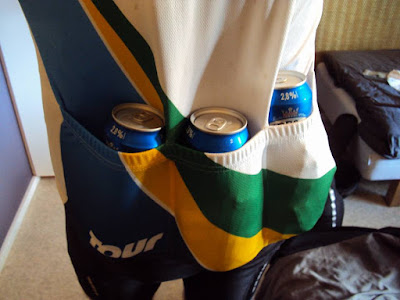After a long day on the road, we finally made it to
Agrigento as the sun set. In the dying light I caught a glimpse of the new
city, high and to our right on a hill top. Then, also to our right but lower
down, my eye was drawn from the road to the unmistakable sight of ancient Greek
columns. I dragged my eyes away, overriding my instinct to save the sight for
the next day.
ANCIENT AKRAGAS
We awoke early and excited. After a nice walk across the
sand dunes, staring out across the sea in the rough direction of Africa, we
headed to the highlight of the region, the ruins of ancient Akragas. We were
waiting at the gates as they opened, champing at the bit.
Founded by Greek colonists from Gela some 2,600 years ago,
Akragas (Agrigentum was the Latin name, hence modern Agrigento) grew to be one
of the largest cities of the ancient world, numbering in the hundreds of
thousands, with monumental ambition to match. Its zenith was not to last for
long. The Carthaginians conquered it within two centuries of its foundation,
before it was knocked back and forth between Rome and Carthage (with the Romans
at one point selling its inhabitants into slavery). After a long age of peace
under the Romans and Byzantium, the core of the ancient city was eventually
abandoned to its fate when the locals moved up hill to a more defendable site
in the face of Arab invasions.
The majority of excavated sites lie along an ancient sacred
way, running East to West. We started from the East right under the eaves of
the Temple of Hera. Situated on a hillock overlooking the valley below and the
see beyond, it is quite a sight with its towering columns largely intact. I
felt dwarfed beneath it. I was delighted to see the kids genuinely excited by
the temple, though perhaps predominantly as a potential climbing frame - it
took quite an effort to stop them clambering all over it.
From here we walked along the sacred way, stopping for shade
and to gawp at one magnificent sight after another. The highlight was
undoubtedly the Temple of Concordia. When I saw it, I did a double-take. Not
only is it imposing and beautiful in its classic design and simplicity, but,
remarkably, it is intact.
Saved by a combination of its brilliant design (this
is an earthquake zone after all) and upkeep resulting from a church squatting
within, it stands tall from a time half a millennium before Christ.
When we finally moved on, I found myself repeatedly looking
back, not wanting to say farewell to such a perfect building.
The temples just kept on coming – this is known as the
Valley if the Temples after all - and had not stopped by the time the sun was a
bit too hot and the kids were tired out. Amongst the other sites we did get to
visit, I would be amiss without saying a couple of words about the ruins of the
Temple of Zeus.
Strewn across the site are massive pieces of masonry, often grasped by the gnarled roots of age-old olive trees. The
fragments of columns were of a scale I have never seen before. Fitting, as they
belonged to what was believed to be the largest Doric temple ever built. It was
a place for scrambling and exploration, trying to paint a picture for the
children (and ourselves) of what this place would have looked and felt like
before its collapse.
Akragas lived a torrid, difficult history. What is left
behind for us to explore is a startling collection of temples and remnants of
ancient life. It is fitting that this place, and specifically the Temple of
Concordia, is the basis for the UNESCO World Heritage emblem. What is surprising
is that this place is relatively unknown. I for one was not aware of it before
researching Sicily. Mistake rectified.
DESOLATE DRIVE
Departing Agrigento, we followed the coast for an hour
before cutting in land to theoretically short cut our journey to the North-East
corner of Sicily. It proved a side bar adventure. Questionable navigation took
us onto smaller and smaller roads until we were winding across isolated areas
of countryside on rough single-track roads.
It was not that this was wild land, indeed it was still
mostly cultivated in one form or another, but it was abandoned by its people.
It was littered with broken down shells of stone dwellings varying greatly in
size. All that was left of the thousands of families that abandoned an
impoverished Sicilian life for fresh shores. It is estimated that over one
million people emigrated to the US from Sicily between 1880 and 1930 alone. An
astounding number which has left parts of Sicily with an eerie sense of
abandonment.
After many a wrong turn we eventually made it to our stop off, Mozia. It proved to be a surprising place in more ways than one.
MOZIA - RUINS, SALT AND A SERPENT
Mozia itself is a small island situated in a shallow lagoon
in the middle of Sicily’s West coast. Many are drawn here by the salt pans and
windmills that criss-cross the flat lands leading up to the island. These are
pretty and interesting, providing much of the wealth of this region for
centuries (salt was an expensive commodity). What drew us here was though the
island itself.
Mozia had been a significant Phoenician city and trading
post from the eighth century BC, until a Syracusan Greek siege and resulting slaughter
forced its decline a few centuries later. Riding out in a small boat, we could
see why the place held out for so long. The lagoon creates a defendable channel
which the Phoenicians knew how to use.
We spent a couple of hours exploring the island and what is
left of the Phoenician civilization. This is not a place of free standing
columns and grand surviving buildings. It is ground level archaeology. Pits all
over the place for our kids to fall down amongst the salt sprayed brush and
thicket.
The most interesting remains centred around a rectangular sacred pool,
known as the Temple of Baal. One theory based on recent excavations and
previous partial finds is that a huge statue of an unknown god or goddess rose
out high from the centre of the pool. It was tantalising to have even a hint of
such mysterious deities and try and imagine what forgotten rituals ruled here
millennia ago.
Cutting back in land to avoid the wind, I was pushing the
pram along a path with our daughter in the pram and the middle one on the buggy board. Out of
nowhere a black snake shot onto the path and right for the pram and my
daughter’s dangling legs. Before having time to think I bunny hopped the pram,
buggy board and children clear over the snake, who brushed past my foot and
disappeared off the other side of the path.
It had lasted less than 5 seconds, but shaken us all up. I
am sure the snake was as startled as us and probably just trying to get away,
but nonetheless a jet-black snake had slithered towards our kids at break neck
speed and we had no wish to see any more. With me acting as point and stamping
loudly, we found the quickest way back to the boat and sailed home. A good story
when over.
With our new serpentine friend behind us (from a bit of
research my best guess is that was a western whip snake) we clambered back in
the car and drove until dark in the direction of the village of Scopello,
hugging to the gulf of Castellammare. It was to prove my favourite place in
Sicily…























































